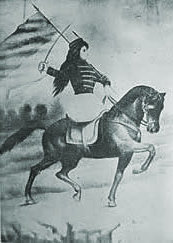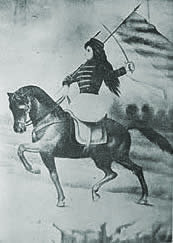
|
Women and Independence in Latin America An exploration of women's involvement in the Latin American Wars of Independence |

|

|
Women and Independence in Latin America An exploration of women's involvement in the Latin American Wars of Independence |

|
Click on the image below to see the full-size image
 Exile 1814 |
Gender:Female
Ethnic origen: White
Events:
| 1791 | - | Bogotá | - | Unknown | - | She married Dr. Francisco García Hevia on 23 July 1791. |
| 1810 | - | Bogotá | - | Unknown | - | She marched against the Spanish government on 20 July 1810. |
| 1815 | - | Bogotá | - | Unknown | - | She was part of a revolutionary spy network in Bogotá around this time. |
| 1816 | - | Cogua | - | Unknown | - | After her husband was executed she was forced into exile to Cogua in August 1816. |
| 1816 | - | Cogua | - | Unknown | - | Her husband was executed in August. |
Connections:
female relatives of executed patriotsBiography:
From Bogotá, she was the daughter of Antonio Nava and Isabel Serrano y Durán, from a noble Asturias family. (Monsalve, 138)
When La Pola was aged 20 (around 1815) she moved to Bogotá and, together with Juana Petronila Nava de García Evía, Andrea Ricaurte de Lozano and Carmen Rodríguez de Gaitan, formed a revolutionary group. They passed information on about the guerrillos de Casanare, royalist troops, state of arms, forces and munitions. (Zabala, 41)
She was among a group of women who marched through the streets of Bogotá against the Spanish government on 20 July 1810. Her children, nephews and nieces accompanied her. She was married to Dr. García de Hevia. (Monsalve, 85)
She married García de Hevia on 23 July 1791. He was executed by the royalists on 6 July 1816. She was a close relative of Dr Fernando Serrano, and the later General José María Durán and other patriots in Socorro and Pamploma provinces. On 4 July 1816 Morrillo's troops arrived at her home to take an inventory of all she had and to confiscate her wealth and imprisoned García de Hevia and their sons. She offered money and her friends collected all the silver and funds they could to save García de Hevia. Morillo accepted the "payment" but shot García de Hevia anyway and kept the sons imprisoned. She was probably held in the Cárcel Chiquita and in August 1816 had to march on foot with the "common soldiers" into exile through the mountains to Cajicá, then Puente del Común and later to Cogua. (Monsalve, 138-139, 159)
References:
Romero de Valle, Emilia (editor). (1948) Mujeres de América
Monsalve, José D (1926) Mujeres de la independencia